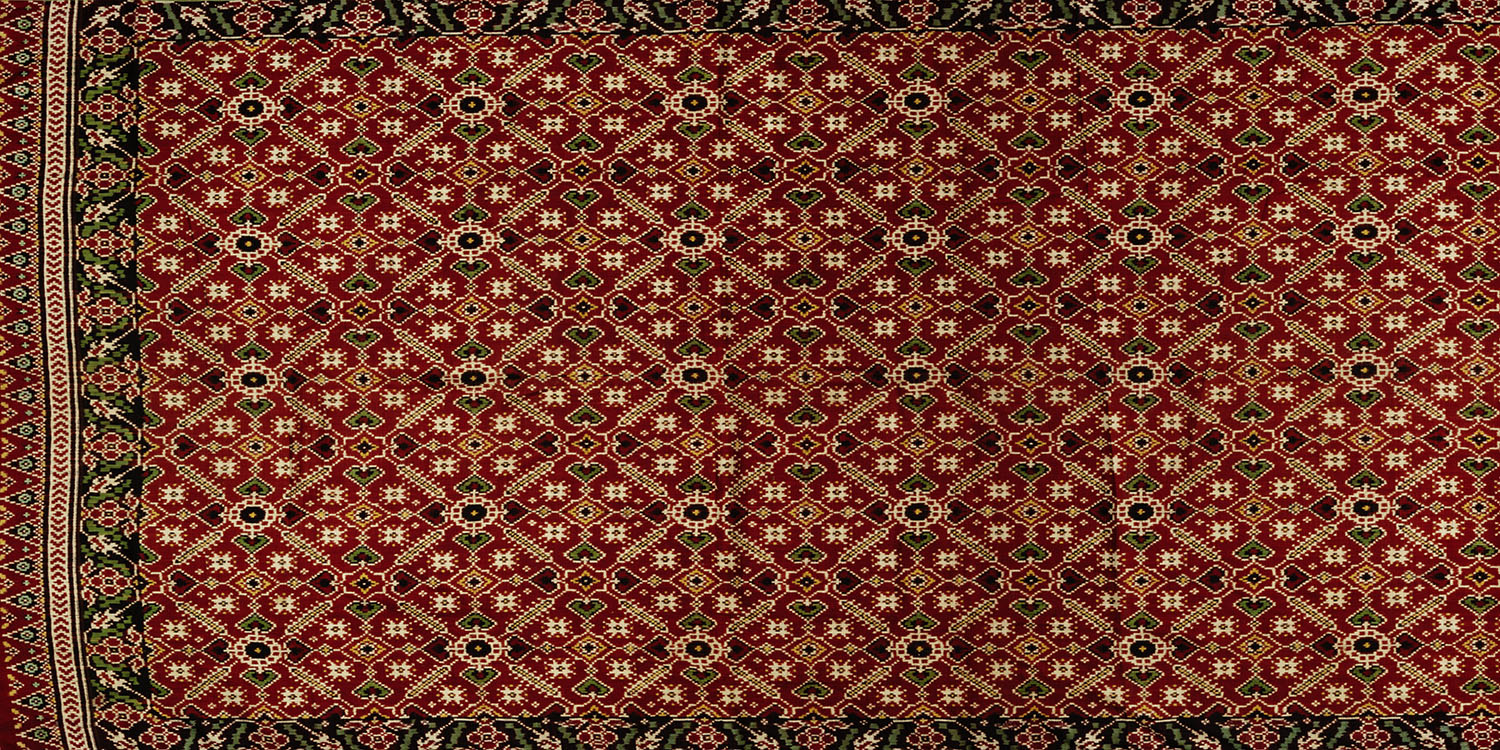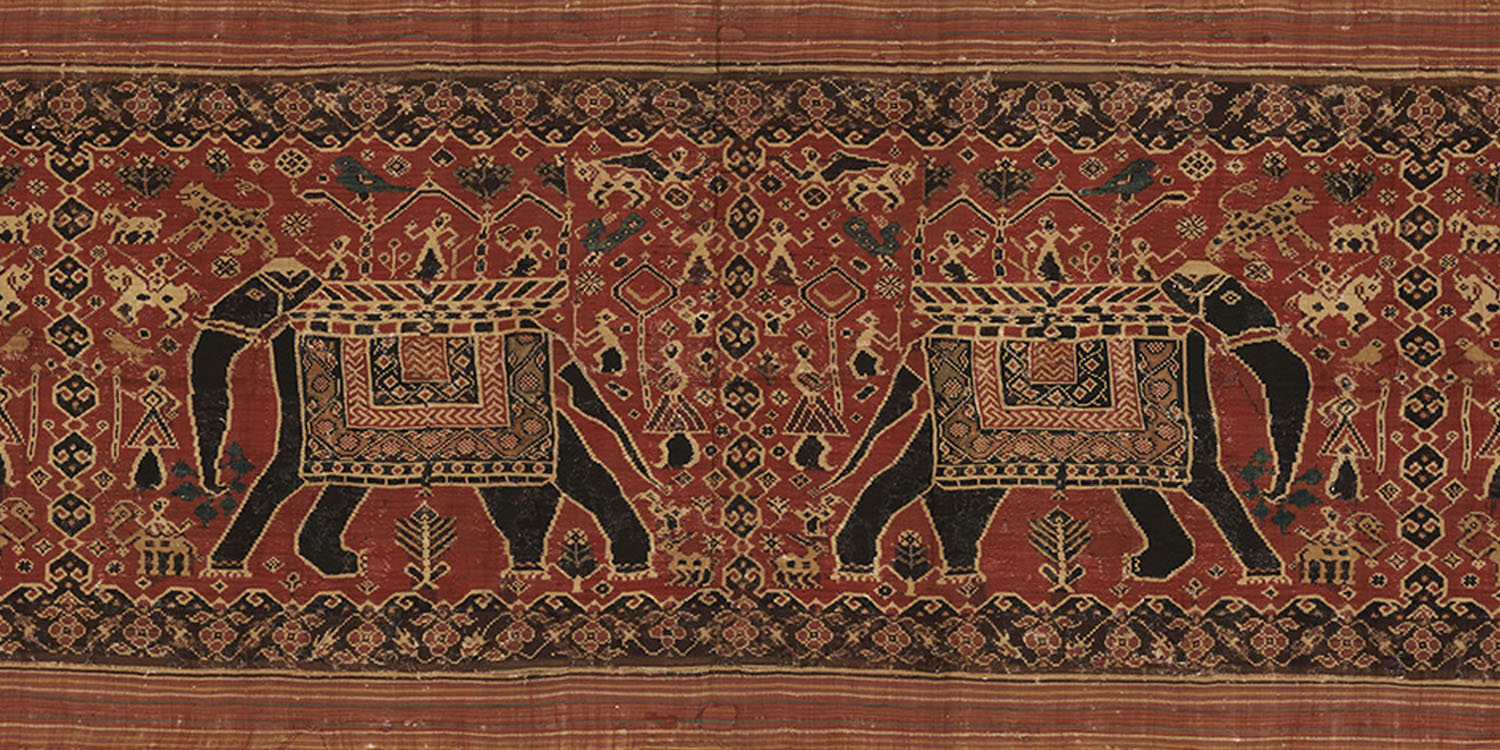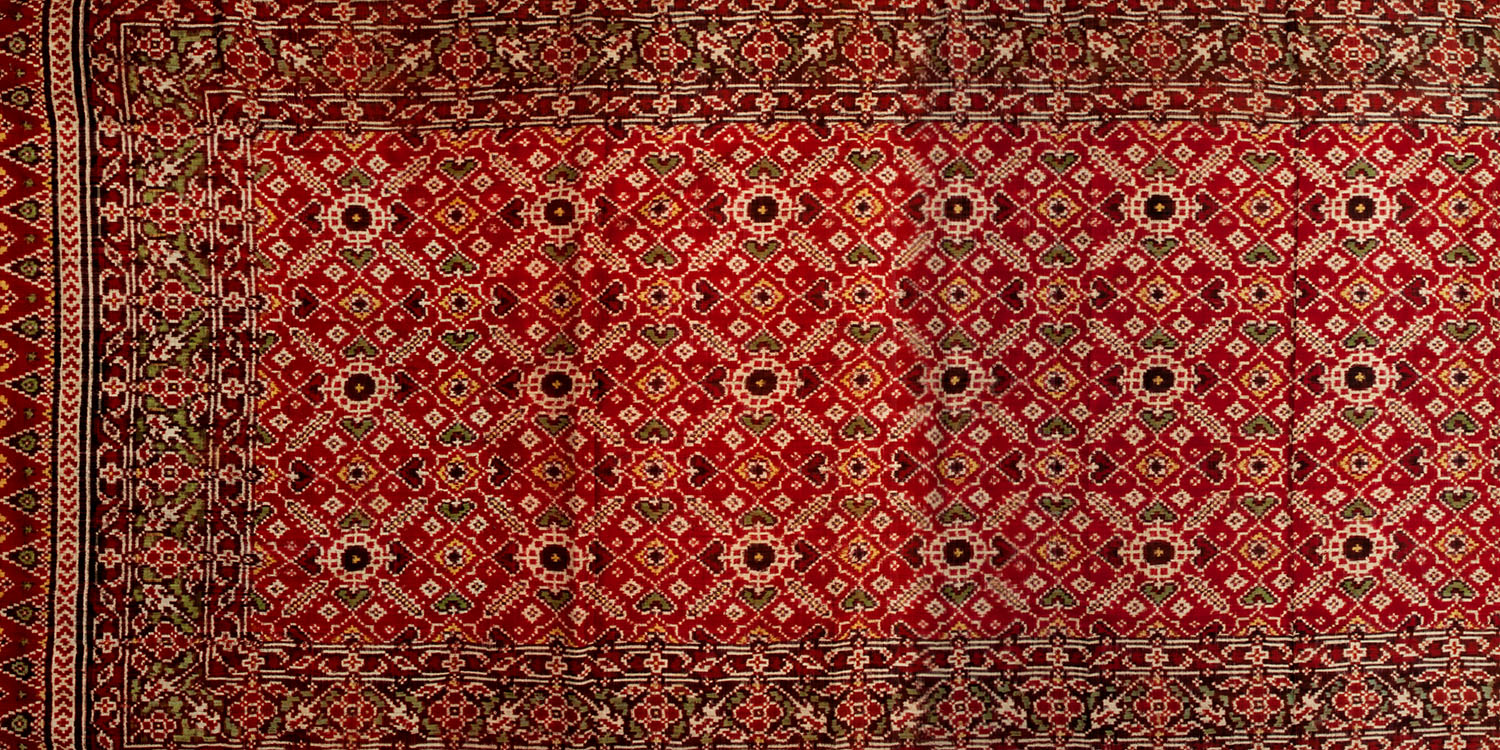ARTICLE
Patola Weaving
A traditional method of weaving fabric, patola weaving follows the double ikat resist-dyeing method, in which both the warp and weft are both resist-tied and dyed before the weaving begins. Patola are known for their rich colours and patterns and sharply defined motifs, which are achieved through the meticulous preparation of warp and weft threads, followed by resist-dyeing and, finally, weaving.
The first step in weaving a patolu – the singular form of patola – is the preparation of the yarn. Patola have been traditionally made of silk procured from China or sourced locally. Today, silk procured from Japan is usually given preference. The fine filaments of silk are opened from their skeins and are rewound using a hand reel. Once this process is completed, eight filaments (the number may vary slightly depending on the design) are twisted together to create an eight-ply silk yarn, which is first wound onto a hand reel, then soaked in water and, while still wet, wound into hanks. These hanks then undergo the degumming process, where they are soaked in boiling water mixed with soda ash and oily soap. Following degumming, the hanks are again wound onto spools, with care taken to maintain even tension. This process sets the base for the preparation of the warp and weft.
The warp is locally known as tano. The main tool used to prepare the yarn is a set of pegs mounted on a wall. The number and position of these pegs can be altered, depending on the length of the warp required. Twelve spools of yarn are placed in front of the wall and a wooden bar with small rings is suspended above the spools. Each thread is guided from the spool through the rings on the suspended bar into a guide rod, which has a similar arrangement of rings. The individual preparing the warp collects the ends of the twelve yarns and fixes them on the outermost peg. They then wind the guide rod around the pegs in such a way that groups of twelve threads are prepared. A helper aids in separating the threads and marking out crosses of yarn and folds such that the warp remains untangled. Usually, a warp-length of around nineteen metres – equivalent to three patola saris – is prepared at one time.
The warp threads are then removed from the wall and are stretched out fully on a frame, where they are kept taut and in order with the help of wooden sticks. After this, the leasing of the threads takes place, with the help of leasing rods and cord, and units are sectioned off along the warp length. Using a thread dipped in a solution of charcoal and water, three sections are marked along the length of the warp, one for each sari. Before the cloth is folded, the weaver and helpers check for threads to ensure they are separate and any broken threads are fixed at this stage. The warp is then crossed and folded and folded again in such a way that six layers of warp are assembled. The middle portions of the patola – where the pattern is prominent – are all arranged on top of one another, while the end warp portions remain on one side.
The weft is prepared on a beam – locally known as paati tanvanu – on which a peg and an iron rod are fixed at either end. The position of the iron rod can be adjusted depending on the width of the fabric to be prepared. Near the beam, a set of cords are placed, which serve as leasing cords, separating sets as they are being wound. Yarn from six spools is first passed through the rings on the suspended wooden barn, then gathered by the individual and wound around the wooden and iron pegs. A leasing thread is added after each round to separate the weft sets, which contain twelve threads each. This process is followed until the required number of weft sets are ready. Like the warp, the weft sets are prepared in a manner such that they can be tied and dyed together with subgroups for repeat motifs. In relation to the warp prepared for three patola saris, weft sets for two patola are made at one time, using the process mentioned above, while the weft set for the third patolu is made separately.
For tying, the warp sheet is folded and stretched on an eight-yard length, and the weft is stretched on a frame of 48.5 inches, which corresponds to its width on the loom. The grid is marked using thread dipped in charcoal and the ties are then added using double ply cotton cords. Larger sections reserved for the resist are wrapped in plastic. While designs are mapped out on graph paper, the master artisans doing the tying can usually do so without the aid of a graph or design chart, tying basic designs from memory. Some traditional patterns include the pan bhat and fulvadi bhat, which are recurring rows of leaves and flowers. A pattern of rectangles filled with a diagonal box enclosing a geometric motif is called ratan chowk bhat, while a trellis-like pattern with the boxes comprising elephants, parrots and a woman is known as nari kunjar bhat.
The warp and weft undergo multiple dyeing cycles and, between each cycle, they are mounted on to the respective frames to open or add reserves. The yarn is generally dyed first in red, then yellow, blue and black. Traditionally, arns are dyed orange before yellow and green is added before blue. Before the dyeing process begins, the yarn is immersed in cold water for a day or two, to ensure it better absorbs the dye. Patan patola are traditionally dyed in natural dyes derived from plants such as madder, indigo, turmeric, pomegranate and gooseberry, among others.
Following this step, the warp is fully unfolded and, using the leasing sticks and leasing cords in, the groups and threads are separated and arranged properly. The tension of the warp is constantly monitored at this stage and threads that break due to the stretching and slacking are mended. The warp yarn for borders – usually ikat-patterned and single colour – is added next to the main field at this stage, having already been prepared and stored separately. The loom is thoroughly cleaned before the warp is fixed. Only three to five metres of the warp are set on the loom in the form of a sheet, with the rest of the warp carefully tied in a bundle and hung above the loom to be opened as weaving progresses. Starch made from rice water is sprayed to the opened warp and, as the fabric is woven, a few inches of the warp are also moistened with water. Once the weft is dyed, it is wound onto bobbins, which are arranged in a sequence corresponding to the pattern. The bobbins are kept in water and are filled into the shuttle while still wet.
A Patan patola is woven on a simple horizontal handloom, which has two string heddle bars and a lever, but no foot pedal. The lever is used to move the heddle. The weft is passed through a shuttle, which is made of bamboo. The weaving process is a two-person job: The weaver sits on the right, operates the heddle device and passes the shuttle from the right. The helper, seated on the left, ensures the right sequence of weft yarns are fed into the shuttle and throws the shuttle from the left side. Every few inches, both sides of the finished textile are rubbed with a steel plate to remove excess starch. The pair also align the threads to ensure a sharp demarcation of the pattern by using pencil-sized needles that push the warp threads sideways and the weft threads inside.
A white cloth separates each roll of the finished fabric at the weaver’s end. Once the weaving is complete, the full fabric is cut into three different patola and smoothened with the use of a half-round plate. No other treatments are done to the final textile, which is ready for sale. Patola weavers also create stoles, dupattas and scarves using the same process, with a few changes to the design of the fabric.
Bibliography
Our website is currently undergoing maintenance and re-design, due to which we have had to take down some of our bibliographies. While these will be re-published shortly, you can request references for specific articles by writing to hellomapacademy@map-india.org.









